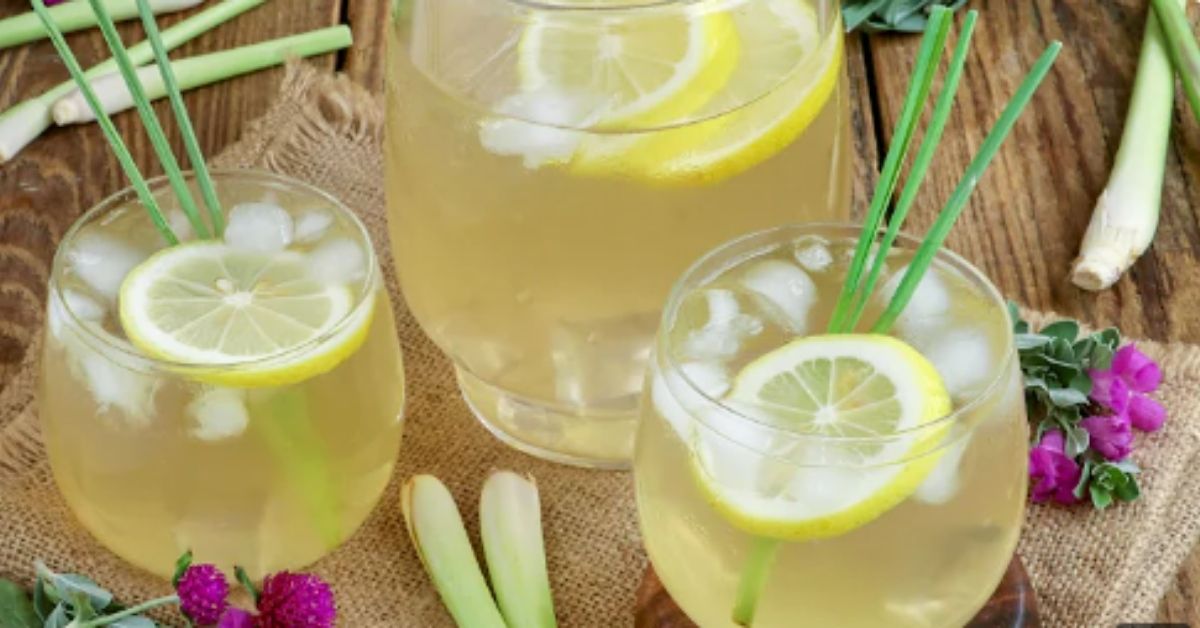Imagine starting your day with a zesty twist of lemongrass juice, a refreshing beverage that not only awakens your senses but also packs a punch of health benefits. Lemongrass, a staple in Asian cuisine, is renowned for its aromatic flavor and has been celebrated for its medicinal properties for centuries. This vibrant herb brings a citrusy zest that can transform any drink into an exotic escape.
Diving into the world of lemongrass juice, you’ll find it’s surprisingly easy to make and can be a delightful addition to your daily routine. Whether you’re looking to boost your digestion, enjoy a moment of calm, or simply seeking a delicious alternative to plain water, lemongrass juice offers a unique blend of flavor and wellness. Let’s explore how to harness the crisp, clean taste of lemongrass in a refreshing glass of homemade juice.
Ingredients
To start your journey into the aromatic world of lemongrass juice, you’ll first need to gather a few key ingredients. Here’s what you need to create this refreshing beverage.
Fresh Lemongrass
- 4 stalks of fresh lemongrass – Ensure that they are firm and pale green in color. Remove the outer tough layers and use only the tender inner part of the stalks.
- 4 cups of water – This will be used to extract the juice from the lemongrass.
- 1/4 cup of sugar or honey – Adjust according to your sweetness preference.
- 2 tablespoons of lime juice – Freshly squeezed for the best flavor.
- Mint leaves – A handful for garnish and to add a fresh, minty accent.
- Ginger slice – A small piece, about an inch, peeled and thinly sliced, to add a spicy kick to your drink. Optional for those who enjoy a little extra zing.
Required Tools and Equipment
To make lemongrass juice that captures the essence of this aromatic plant and transforms it into a refreshing drink, you need the right tools and equipment. Here’s what you’ll require to ensure a smooth preparation process:
Juicer or Blender
A high-quality juicer or blender is essential for extracting the juice from lemongrass stalks efficiently. If you are using a blender, ensure it has sharp blades to handle the fibrous nature of lemongrass.
Fine Mesh Strainer or Cheesecloth
To achieve a smooth and clear lemongrass juice, use a fine mesh strainer or cheesecloth. This will help you filter out the fibrous parts and any residue, leaving you with a pure liquid.
Knife and Cutting Board
A sharp knife and a sturdy cutting board are crucial for prepping your ingredients. You’ll need to finely chop or crush the lemongrass to release its flavors effectively.
Measuring Cups and Spoons
Accurate measuring tools are key to balancing the flavors in your lemongrass juice. Ensure you have measuring cups and spoons on hand to measure water, sugar or honey, and lime juice.
Pitcher or Large Bowl
A large pitcher or bowl is useful for mixing your ingredients and allowing the flavors to meld. Opt for a container that gives you enough space to stir comfortably.
Spoon or Stirring Stick
To mix your ingredients thoroughly and ensure the sugar or honey dissolves completely, use a long spoon or a stirring stick.
By gathering these tools and equipment before you start, you set yourself up for success in making a delicious and invigorating lemongrass juice.
Preparation
Now that you have all your tools ready, let’s dive into the preparation process to make your refreshing lemongrass juice.
Cleaning and Chopping Lemongrass
- Select Fresh Lemongrass: Start by choosing fresh, firm lemongrass stalks. These should have a pale green hue and fragrant lemon-citrus aroma.
- Wash Thoroughly: Rinse the lemongrass stalks under cold running water to remove any dirt or impurities. Be meticulous as the outer layers can harbor dust and debris.
- Peel Outer Layers: Remove and discard the outer layers of the lemongrass stalks until you reach the more tender part of the stem.
- Cut into Pieces: Using a sharp knife, slice the lemongrass into 2-inch long pieces. Smaller pieces ensure more surface area for releasing the essence during the blending or juicing process.
- Crush the Pieces: Lightly crush these pieces using the flat side of your knife or a pestle. This step helps to release the flavorful oils and maximizes the citrusy zest in your juice.
- Lemon and Honey: If chosen to enhance the flavor and benefits, prepare one lemon by cutting it into halves and squeezing its juice. Measure out approximately two tablespoons of lemon juice. In addition, ready two tablespoons of honey to sweeten and blend well with the aromatic profile of lemongrass.
- Ginger Root: Peel about an inch of ginger root and then grate or finely chop it. Ginger adds a spicy note and additional health benefits, amplifying the invigorating quality of your lemongrass juice.
- Water: Measure out four cups of water. This will be used to blend with the lemongrass and other ingredients to create the right consistency and dilution for your juice.
With all ingredients well-prepared and organized, you’re set to start combining them effectively to craft your refreshing lemongrass juice.
Making Lemongrass Juice
Now let’s dive into the heart of making lemongrass juice, ensuring every sip is infused with its vibrant, citrusy essence and health-enhancing properties.
Extracting the Juice
Start by gathering your freshly washed lemongrass stalks. Using a sharp knife, trim off the root end and remove any dry outer layers. Finely chop the remaining stalk to help release more flavor during the juicing process. If you’re using a blender, add the chopped lemongrass into the blender jar. Pour in about 1 cup of water to help facilitate smooth blending. Blend on high speed until the mixture is thoroughly processed.
For those using a juicer, feed the chopped lemongrass stalks directly into your juicer. Continue processing until all the lemongrass is juiced. The high-speed action of the juicer will extract the juice along with the essential oils, which are key to the flavor and aroma of the juice.
Straining the Juice
After extracting the lemongrass juice, the next step is to ensure the juice is smooth and free from fibrous pieces. Pour the blended lemongrass mixture through a fine mesh strainer or a cheesecloth into a large bowl or pitcher. Use a spoon or a spatula to press against the pulp in the strainer to squeeze out as much liquid as possible.
If using a cheesecloth, gather the corners and twist the bundle tightly, pressing to expel all the flavorful juice. This straining process clarifies the juice and creates a more refined and enjoyable drink. Ensure all the juice is collected, leaving the fibrous material behind. Your lemongrish juice is now ready to be combined with other ingredients or served as desired.
Storing and Serving Tips
After perfecting your lemonglass juice, proper storage and serving can dramatically influence its freshness and taste. Here’s how to keep your juice as vibrant and flavorful as when you first made it.
How to Store Lemongrass Juice
To maximize the shelf life of your freshly squeezed lemongrass juice, always store it in a well-sealed container. Glass containers are ideal as they do not impart any unwanted flavors into the juice. Transfer the juice to the container immediately after straining and seal it tightly to minimize the exposure to air, which can accelerate oxidation and spoilage.
Place the sealed container in the refrigerator to maintain freshness. Lemongrass juice should be consumed within 2-3 days for the best quality and flavor. For longer storage, consider freezing the juice in an ice cube tray. Once frozen, transfer the lemongrass juice cubes to a freezer-safe bag for use for up to one month. This method not only preserves the juice but also provides an easy way to add a splash of lemongrass flavor to drinks or dishes.
Serving Suggestions
Lemongrass juice offers versatility in both drink and culinary applications. Serve the juice chilled for an invigorating and refreshing beverage. To enhance its natural flavors, add a squeeze of lime and a teaspoon of honey or agave syrup. This mixture creates a perfect balance of sweet and tangy, making it a delightful drink for hot days.
For a festive twist, mix lemongrass juice with sparkling water and serve it in a champagne flute garnished with a sprig of mint or a slice of cucumber. This concoction makes a sophisticated, non-alcoholic drink suitable for any celebration.
In culinary uses, incorporate lemongrass juice into your cooking by using it as a marinade for seafood or chicken. The juice imparts a subtle citrusy essence that brightens the flavors of your dishes. Additionally, you can use it in dressings for fresh salads or as a vibrant addition to soups and broths, enhancing depth and freshness.
Conclusion
Exploring the vibrant world of lemongrass juice opens up a variety of culinary possibilities. Whether you’re sipping it as a refreshing drink enhanced with lime and honey or using it to add a zesty flavor to your dishes the benefits are clear. Remember to store your juice correctly to preserve its freshness and enjoy the delightful flavors lemongrass has to offer. Embrace the versatility of lemongrass juice in your cooking and beverage repertoire and watch it transform your meals and refreshments into something truly special.
Related Posts:
- Top Morning Juicing Recipes for a Refreshing Start: Tips & Ideas
- Refresh Your Summer: Top Juicing Recipes for a Healthy Season
- Refreshing Radish Juicing Recipes: Boost Health with Flavorful Drinks
- Ultimate Migraine Juice Recipe: Natural Relief with Fresh Ingredients
- Ultimate Hot Shot Recipe: Boost Your Health with Ginger, Lemon & Cayenne
- How to Make and Serve Fresh Lemongrass Juice: Tips & Benefits
- Bok Choy Juicing: Ultimate Guide to Ingredients, Prep, and Storage
- Chia Seeds and Juice: A Refreshing Guide to Nutritious Drinks
- Top Juice Recipes for Allergies: Natural Relief with Fruits & Veggies


